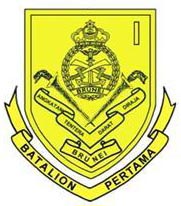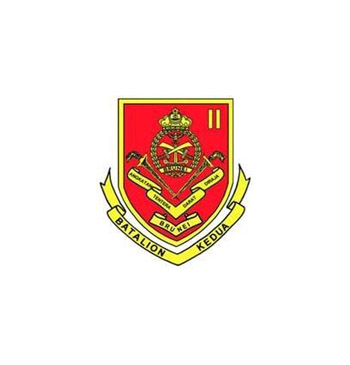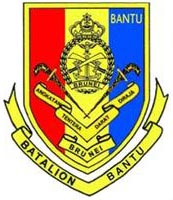

First Battalion
Established in 1962, the organisation consisted of the first three intakes undertaking basic military training. At the beginning, the organisation was setup in Segenting Camp,Port Dickson, Malaysia. After the development of Berakas Garrison in 1975, the organisation was then change to the First Battalion Land Force. Under the command of Colonel J.F Davis, the force consisted of the various departments. This departments included Markas Company, Rifle Company A, B, C, D and E.

Second Battalion
Formed on the 2nd of January 1975, it resited temporary at Bolkiah Garrison. In the beggining, the Battalion was occupied by Company B and E of the First Battalion under the command of Commanding Officer at that time Leftenan Colonel A.E Hibbert. The battalion then change to its new location and on the 10th of May 1976 the Second Battalion was moved to Tutong Camp. Following the formation of the second battalion, Pengiran Ratna Indera Leftenen Colonel Pengiran Dato Setia Ibnu bin Pengiran Datu Penghulu Pengiran Haji Apong was then appointed as the commanding officer in charge.

Third Battalion
In 1994, the third battalion was formed. It was granted for establishment on the 31st May 1994 . The battalion was made up of Company D form the First Battalion F Company of the Second Battalion and Command Company from the First and Second Battalion. Maj Shahlan bin Hidup was the first appointed commanding officer in charge of the Battalion. It is located in Penanjong Garisson.

Support Battalion
Support Battalion was first established based on 5 major units namely Armour Reconnaissance Squadron, Combat Engineer Squadron, Air Defence Battery, Penanjong Workshop and Penanjong Garison Headquaters on 2nd January 1990, a historic event took place where Support Battalion was officially established which comprises of 3 major unit namely, Armour Reconnaissance Squadron, Combat Engineer Squadron and Company Headquarters Support Battalion.
Logistic Depot
The history of Logistic Depot Royal Brunei Land Forces began in April 1964 where it first established at Berakas Camp. It was formally named as The Q Branch Headquarters, Brunei Malay Regiment. The Q Branch Headquarter began its operations, handling supply and purchases of logistics through the foreign company Crown Agent. In 1969, Q Branch Headquarters was renamed to Force Ordinance Office (FOO). In 1974, Logistic Depot was established in Berakas Garrison and was later moved to its permanent building in Bolkiah Garrison under the patronage of Support Service, Royal Brunei Armed Forces in 1984. On 2nd January 2009, Logistic Depot came under the umbrella of the Royal Brunei Land Force when Royal Brunei Armed Forces undergone restructuring its forces until to this date.
Land Engineering
Land Engineering was at first established in 1961 consisting of the Workshop Section under the command of Military Transport and at the same time Electronic and Instrument Section under the command of Signal Squadron. In 1975, the 3 section was combined to form Woksyop Askar Melayu Diraja Brunei and built their first workshop in Bolkiah Garrison in 1980, followed by their second workshop in Penanjong Garrison in 1984. In 1999, Land Engineering was then officially established under the command of the Support Services Royal Brunei Armed Forces. Following the disbandment of the Support Services, Land Engineering then became a part of the Royal Brunei Land Forces in 2009.
Medical Services
The Medical Service, Royal Brunei Armed Forces was established in 1964 by a British Loan Service Medical Officer. The Medical Service was established to serve the needs of the Royal Malay Regiment. With humble beginnings, the first Medical Reception Station, or better known as MRS, was established at F13, Jalan Abu Bakar in Berakas Garrison. In 1965, MRS provided service from its current location at Jalan Pandangan Laut, Berakas Garrison. Now, the Medical Service include the Medical Training Wing, Medical Store, Environment and Hygeine Wing and 8 MRS throughout the whole country; Berakas Garrison, Bolkiah Garrison, Muara Naval base, Royal Brunei Air Force, Second Batallion Tutong Camp, Penanjong Garrison, Third Batallion Lumut Camp and Bangar Camp.
Major John Moran, who was later bestowed the title “Pehin Orang Kaya Datu Tabib Laila Di Raja” and decorated with “Dato Seri Paduka“ by His Majesty the Sultan, was the first Chief Medical Officer (CMO); from 1962 until 1992. The current CMO is the 8th and the first local CMO: Colonel (Dr) Mohd Hafizul bin Haji Mohd Hassan. The first male local Medical Officer, Lieutenant Colonel (Dr) Pg Hj Rosman bin Pg Hj Ismail, was enlisted in 1998 and retired in 2013 whilst the first female local Medical Officer, Major (Dr) Norasiah Ahmad, was enlisted in 2008. In 2014, Captain (Dr) Siti Nur’Raheemah binti PDML DP Hj Musa joined the medical services; she was awarded the Supreme Commander’s Scholarship in 2006.
As more local Medical Officers joined the Medical Service, the British Loan Service was ceased in 2011. However, the secondment of Pakistani Army Medical Officers started in 2014, in order to allow local Medical Officers to progress professionally. Currently there are 20 officers serving in the Medical Service; 10 local Medical Officers (including 4 female Medical Officers), 4 Seconded Pakistani Army Medical Officers, 1 Administrative Officer and 1 Training Officer. There are 142 military staff (98 male and 44 female) and 105 Civilian staff.
The Royal Brunei Armed Forces Medical Service has been involved in a number of international deployments including United Nations Interim Force in Lebanon Peacekeeping Mission, International Monitoring Team to Mindanao, Republic of the Philippines and HADR Mission to Aceh, Indonesia. Representatives of the RBAF Medical Service has also participated in a number of international Ex. In 2013, RBAF hosted the ADMM-Plus HADR/Military Medicine Exercise.
After 51 years, the Medical Service’s future plans include the building of the Military Hospital in Bolkiah Garrison and the extension of services not only to military personnel and their families but to civilian personnel within the Ministry of Defence as well. The Medical Service is also looking into conducting a number of research which will look at improving the service provided.
Dental Services
Dental Services initially started as a department established in 1972 under the Royal Brunei Malay Regiment. It was then located in a small annex to the MRS Medical Centre in Berakas Garison and provided routine care and emergency dental care for military personnel and their dependents. The department consisted of two dental surgeries, a reception, a waiting room and a single dental laboratory. The department was staffed by Major R. Hubbard, a UK Contract Dental Officer, two local military Dental Surgery Assistants and a civilian receptionist.
Today, Dental Services is comprised of six Dental Centres located in Berakas Garison, Lumut Garison, Tutong Garison, Penanjong Garison, Rimba Airbase and Muara Naval Base, headed by a central Dental Headquarters in Berakas Garison. Clinical facilities have steadily expanded over the years to now total 22 Dental Surgeries, 3 Dental Laboratories, Dental Stores and Procurement Offices and a Dental Equipment Maintenance Workshop. Comprehensive primary oral healthcare services are provided by a staff of 65 military and 25 civilian personnel which includes: 7 Dental Officers, 12 Dental Technicians, 5 Dental Hygienists, 5 Dental Therapists, 24 Dental Surgery Assistants and various supporting staff.
Based on its Strategic Plan of 2010, Dental Services's organisational vision is 'Towards a Quality, Professional and Resource-Efficient Dental Services' which is strongly supported by its Clinical Governance initiative, its recent Dental Career Roadmap and establishment of running contracts. Apart from executing its primary mission of providing effective dental service support to the RBAF, it contributes towards optimising the operational readiness of RBAF personnel by ensuring that they are dentally fit for deployment via active RBAF Dental Fitness State KPI monitoring and reporting.
Fire and Safety
Established in 1971, this unit is responsible in fighting fire and saving lives. This unit comprised of five fire stations throughout the forces and one under the administration of TUDB. Those fire stations are Royal Brunei Navy Fire Station, Berakas Garrison Fire Station, Penanjong Garrison Fire Station, Tutong Camp Fire Station and Lumut Camp Fire Station. This unit are fully equipped with modern technologies fire fighting gears and as well as fire fighting vehicles. With the vision "TO BE EFFICIENT AND COMPETENT UNIT" and its mission "TO PROVIDE PROMPT AND EFFECTIVE ASSISTANT", this unit will be expended according to the changes of today's development.
Signal Squadron
�The formation of Signal Squadron Unit in the Royal Brunei Malay Regiment was in the early 70’s which was known as Signal Troop, under the administrative of Royal Brunei Malay Regiment headquarter and under the command of GSO (General Staff Officer) Signals that Maj (LS) Tim Mc Coy, Loan Officer of the British Army.
At the beginning of the establishment of this unit has been placed in the building currently occupied by the office of the Public Administration, Berakas Garrison. Led by WO (LS) Taylor until first local take over the leadership as chairman of Signals Troop Cpt Johari bin Haji Abd Razak by the end of the 70’s.
At that time these unit only has the number of members of the approximately 20 - 30 members of military personnel. The lack of tools and equipment making the ability to operate very limited. Main communication equipment is using PRC (Portable Radio Clansman) 351 Clansman and VRQ (Vehicle Radio Quick Fit) 301.
In 1982, with the growing role of this unit, the organizational structure of Signals Troop been rearranged and expanded in accordance with the requirements of the Royal Brunei Malay Regiment at that time.
This unit was renamed and known by the name of Signal Squadron. The opening of the establishment of Signals Squadron was held on 1st September 1982 by the Royal Brunei Malay Regiment Commander, Brigadier General JPW Friedberger.
In accordance with the changes to the organizational structure, Signal Squadron now has 2 branches or sub unit namely Radio Troop and Communication Centre Troop (COMCEN). In 1988 another sub unit established in the Signal Squadron namely Signals Troop Employment Service (SME).
Among this unit's involvement in providing assistance such communication is to help long-distance relationship to a rifle company that made military training at another countries like Australia and Hong Kong. The use of HF radio to Brunei training area around the 80’s, which involves 3 – 4 members each detachment of this unit without facing any problem. In addition, this unit has also been involved providing 2 way military training assistance communication, which is named "Eksesais Setia Kawan " to provide effective communication aid during the exercise, and give communication assistance to Fire Brigade in relation to natural disasters such as "Al Nino" and "La Nina" which hit Brunei Darussalam once.
At the beginning of the establishment until now, this unit also saw the participation of women soldiers and Civilian / TEMD especially in the control centers and online communication ICS. After three decades, this unit has been able to prove their ability to shoulder the burden given task and will always move forward and develop according to the sophistication of technology and operational requirements.
Force Transport
Force Transport was established in 1976 and is responsible for handling all types of ground transportation required by all units in the RBAF. Force Transport currently operates in Berakas Garrison and it is the main unit for all Military Transport that available in all units of RBAF.
It also serves to ensure that all vehicles can be used on certain serviceability rate and thus determine all necessary repairs are carried out through Berakas LAD or Bolkiah Workshop. All members of the Force Transport including military and civilian driver is responsible for the maintenance of vehicles used to ensure that the vehicle is likely to be used safely and used in accordance with the prescribed procedures aimed to increase the lifespan of all vehicles used.
Force Transport is also constantly engaged in any transportation needs required during the greatness of state or transportation requests from law enforcement agencies and other government agencies. All members of the Force Transport drivers also undergo upgrading courses available in the Driving Training Branch, Training Institute RBAF to ensure that all members have the training and skills in line with the position held.
Until now, Force Transport has various types of vehicles and vehicle capacity varies depending on the needs and requirements of users and will continue to grow by having vehicles that meet the needs of the RBAF.
